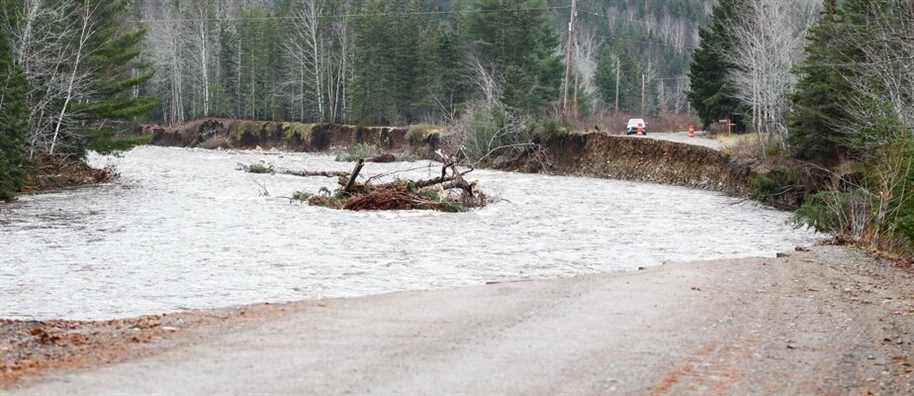After British Columbia, it was the turn of the Atlantic provinces to receive record precipitation in a short period of time. Roads cut in half, schools closed, houses flooded: Newfoundland and Labrador and Nova Scotia were not spared by Mother Nature who struck once again.
In Sydney, Cape Breton Island, Dean Keats’ phone has been ringing continuously for 24 hours. The contractor specializing in post-disaster renovation work has already received some fifty calls from insurance companies to assess the damage to flooded customers. “I worked until 3:00 am last night and started again at 7:00 am this morning. It doesn’t stop. ”
The man who went to college in Quebec said he visited houses that had almost half a meter of water in their basements. “The next few days and weeks will be very busy. ”
Cape Breton, in northeastern Nova Scotia, has been one of the areas hardest hit by the torrential rains that have fallen over the Atlantic provinces in the past two days. Sydney received 150mm of rain, while Ingonish River, about 100 kilometers north of Sydney, received 274mm.
“It’s a slowly moving storm, so it leaves a lot of rain,” explains Bob Robichaud, meteorologist at Environment Canada. But for Nova Scotia, it’s pretty much over, it’s now moving to Newfoundland. “
Parts of Nova Scotia still received 278 mm of rain, shattering a 24-hour precipitation record of 143 mm dating back to 1971.
“It’s difficult to link this event in particular to climate change,” acknowledges Mr. Robichaud. But it is compatible with what we know about it. A warmer climate increases the moisture concentration with heavier rains. ”
Recent events on the Pacific and Atlantic coasts clearly illustrate how Canada’s coastal regions are among the most vulnerable in the country to global warming.
“One of the worst storms I have seen”
The storm hit particularly hard in eastern Nova Scotia, Antigonish, Victoria and Inverness counties. A state of emergency has been declared in Victoria County, where schools have been closed. On Wednesday, the Nova Scotia Emergency Management Office also asked residents of those counties to check road conditions before getting behind the wheel. Several sections of the road were washed away by landslides.
In Newfoundland, the Trans-Canada Highway was closed in several places: the flood damaged the roadway. In Port-aux-Basques, only one access road to the highway was open. The ferry service between the island and Nova Scotia has also been temporarily suspended due to weather conditions. The movement of goods to Newfoundland is also disrupted.

PHOTO FROM NEWFOUNDLAND AND LABRADOR RCMP TWITTER ACCOUNT
Collapsed section of the Trans-Canada Highway in Newfoundland
“It’s been at least five, six years since I have seen such a strong storm,” confided to Press Steve Vardy, who lives in Corner Brook. In Port-aux-Basques, 200 km to the south, the rain literally overwhelmed the city’s sewer system of some 4,000 inhabitants. “It’s one of the worst storms I’ve seen,” says Bruce Edwards.
We’re used to the wind, but it’s the first time I’ve seen so much rain. It just calmed down, but we can’t get into or out of town. It may be like this for a few more days.
Bruce Edwards, resident of Nova Scotia
The city received 147mm of rain during the day, almost as much as in a month, while precipitation for the entire month of November averages 160mm.
On Twitter, Prime Minister Justin Trudeau offered his support to the populations of the Atlantic provinces “who are suffering from extreme weather conditions”. “We’re here for you, and we’re ready to provide any help you and your community may need,” he wrote.
British Columbia’s fingers crossed

PHOTO JENNIFER GAUTHIER, REUTERS
Part of the Trans-Canada Highway remains partially submerged in water in Abbotsford, one of the areas most affected by the flooding in British Columbia in recent days.
Up to 70mm of rain could fall over the Fraser Valley, British Columbia, in the next few hours. The mayor of Abbotsford, the hardest-hit town in the region, said he was optimistic that repairs to the dike surrounding the Sumas Prairie will help contain the new precipitation. “We are as ready as we can be for what is to come. But Henry Braun also admitted that the situation was far from being resolved, citing contamination problems after the floods which notably washed away cars, tractors and agricultural fertilizers. “Keep praying for us, we desperately need it. In Ottawa, the House of Commons announced that it would hold an emergency debate on flooding in the province.

